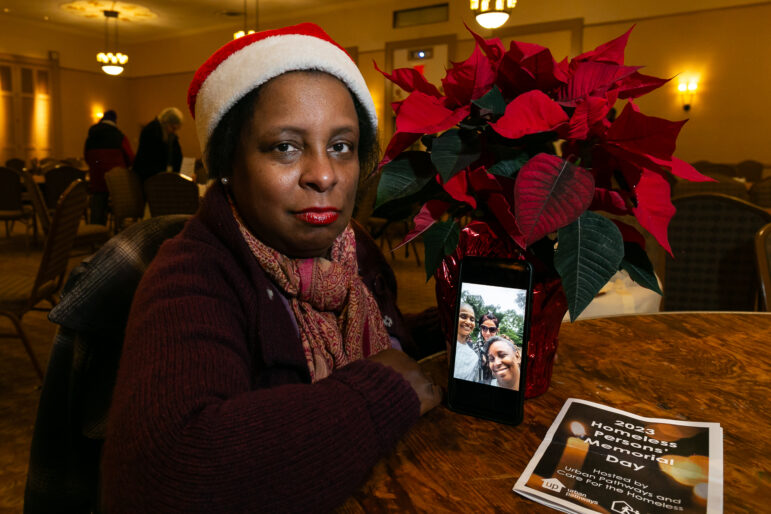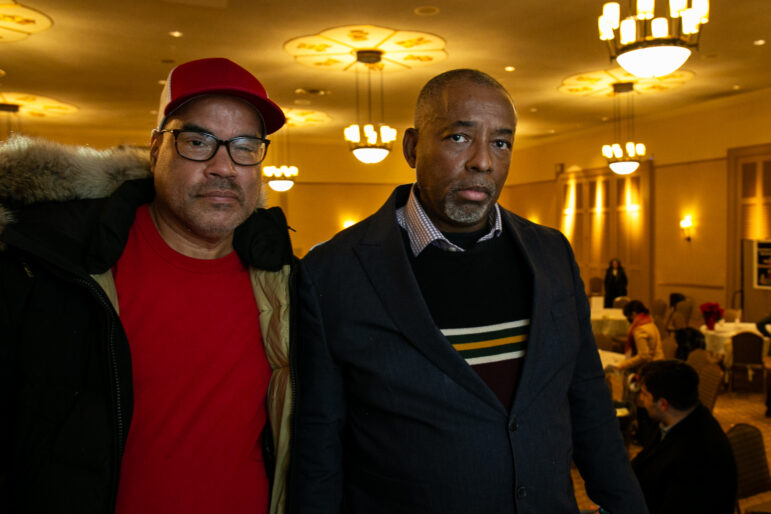“Let us keep in front of mind that these were people who had hopes, dreams and stories,” said George Nashak, CEO of Care for the Homeless.

Adi Talwar
Maria Teresa Walles shares a photo of her late friend Sarah Wilson, center, pictured here with Walles and 2021 mayoral candidate Maya Wiley.Richard Jarrett knew something was wrong when he walked over to his neighbor Kenny’s apartment on a Sunday earlier this year, hoping to share some food. Kenny tended to lose his keys, and usually left the door unlocked, but that day it was shut tight.
Jarrett later learned that Kenny was in the hospital. He passed away on Easter morning at the age of 54, over five years after moving into his own studio apartment in the Bronx, ending a long period living in shelters and on the street. Run by Urban Pathways, the building on 162nd Street has apartments reserved for formerly homeless adults.
“Kenny was funny, very funny, especially to the ladies,” Jarrett told a crowd of friends and advocates gathered at Congregation Rodeph Sholom on the Upper West Side on the evening of Dec. 20. “Kenny was also kind. He would help people who were still living on the street, or living in the park near us. He had a good heart.”
For several years running, Urban Pathways and Care for the Homeless, a shelter and healthcare provider, have hosted Homeless Persons’ Memorial Day to honor hundreds of people who died in the past year and experienced homelessness in life.
Health crises frequently precipitate homelessness, and chronic health conditions are difficult to address without stable housing, said George Nashak, CEO of Care for the Homeless, in his opening remarks.
“Let us keep in front of mind that these were people who had hopes, dreams and stories,” he added.

Adi Talwar
Richard Jarrett, right, and William Ramos remembered their friend and neighbor, Kenny.Advocates and elected officials proceeded to read the names of over 300 dead, pausing between each name for a single bell to toll. Guests at round tables raised candles.
Among those honored was Sarah Wilson, a fixture in housing and homelessness advocacy circles, who died in July at the age of 43. She lived in permanent housing at the time of her passing, following a period in the city’s shelter system.
Wilson was involved in groups including the Safety Net Project at the Urban Justice Center, VOCAL-NY, and Supportive Housing Organized and United Tenants, or SHOUT, and joined other advocates with lived experience of homelessness to pitch policy ideas directly to Mayor Eric Adams’ administration.
She helped fight for a substantial increase in the value of city-issued rental vouchers, and the elimination of a 90-day waiting period for shelter residents to be voucher-eligible. At VOCAL-NY, Wilson was also involved with advocacy at the intersection of homelessness and drug policy, including overdose prevention.
“I first met her through Safety Net at the Urban Justice Center, and then from there all hell broke loose,” said her friend and fellow advocate Maria Teresa Walles. “She was a very powerful young sister. I consider her my little sister.”
Walles stood to eulogize Wilson, wearing a Santa hat because her friend loved the color red. “When I told her that my daughter was going to college, she was very proud of me,” Walles said. “She was so proud of me that she treated me to Wendy’s, and I enjoyed every bit of it.”
The assembled crowd also heard from Meghan Garven, an independent living specialist with the organization BRC, who eulogized her friend and client Omar Gnyp. Gnyp died of an aneurysm in March at the age of 44. He was in a rehabilitation facility at the end of his life, but had been a familiar face to street outreach workers in Jamaica, Queens.
Standing 6’6”, Garven said, Gnyp was hard to miss. He loved movies, and once recounted the entire plot of Top Gun to her, sound effects and all.
“Every Sunday we would talk on the phone and I would help him order groceries on Amazon. I can’t look at an Entenmann’s raspberry danish without thinking of him,” she said. “I helped him buy holiday cards and write thank you notes to the nurses in his facility.”

Adi Talwar
On the evening of December 20, 2023, Urban Pathways and Care for the Homeless hosted the 2023 Homeless Persons’ Memorial Day at Congregation Rodeph Sholom in Schafler Forum at 7 West 83rd Street, Manhattan.This past year saw New York City’s sheltered homeless population spike dramatically. Over 91,000 people slept in Dept. of Homeless Services (DHS) shelters on the night of the memorial service, compared to about 66,600 one year prior.
One contributing factor has been a large influx of new immigrants in New York City, many traveling from the U.S. border with Mexico. Tens of thousands are staying in DHS shelters—largely families with children—while tens of thousands more are in a range of emergency facilities run by other city agencies, from converted hotels to tents.
Bennett Reinhardt, advocacy coordinator with Open Hearts Initiative, read an original poem at the vigil called “Buenos Dias” to honor new arrivals, including an 11-year-old boy who died at a shelter on the Upper West Side on Dec. 11. “Breathe easily now, rest easily now,” he said.
Thanks to a unique set of court decisions, New York City is obligated to provide a shelter bed to anyone in need. Yet these protections, stretching back to the 1980s, are currently fraying, particularly for immigrant adults, who for months have been forced to exit and reapply for shelter after a set period of time.
The city’s official estimate of unsheltered homeless New Yorkers, released once a year, is roughly 4,000 as of January 2023.
Both this year and last saw high profile instances of deadly violence against unhoused New Yorkers. On May 1, 30-year-old Jordan Neely died after fellow subway rider Daniel Penny put him in a fatal chokehold.
In a eulogy for Neely, Urban Pathways CEO Fred Shack also honored Marcel Mungia, a homeless man who was reportedly fatally attacked in Kips Bay in August.
“It’s imperative that we disrupt the culture that poses unhoused people as a threat,” Shack said. “It’s imperative that we recognize that homelessness is not a failure of the individual, it’s a failure of our policies.”
An annual report released by the city reveals other common causes of death among homeless New Yorkers, both sheltered and unsheltered.
The most recent analysis, published earlier this year for the fiscal year that ended in June 2022, recorded 815 deaths, the highest on record. Excluding a subset of the total reported by the Human Resources Administration, the leading causes of death was drug overdose, followed by heart disease, accidents, alcohol dependence and cancer.
Closing out this year’s vigil, Will Woods, a consumer advocate with Urban Pathways, said he felt a mix of sorrow and hope. “As I look around the room I see a space filled with people who care about their city, people who care about their neighbors,” he said.
The crisis of homelessness can be solved, he added, with the creation of safe and affordable homes, and healthcare for every New Yorker.
“So let’s take a moment to take that sorrow, and let’s take that hope, and let’s use them as motivation to create a reality where everyone has a home of their own,” Woods said. “And where we don’t have to keep doing this, right? Where a Homeless Persons’ Memorial Day observance is no longer necessary.”
To reach the reporter behind this story, contact Emma@citylimits.flywheelstaging.com. To reach the editor, contact Jeanmarie@citylimits.flywheelstaging.com








